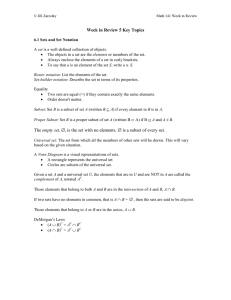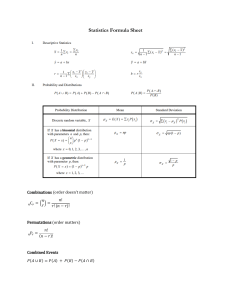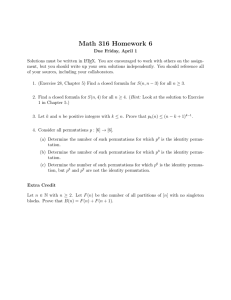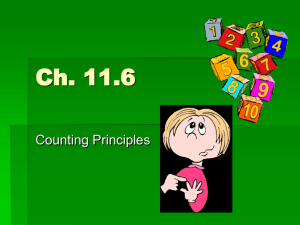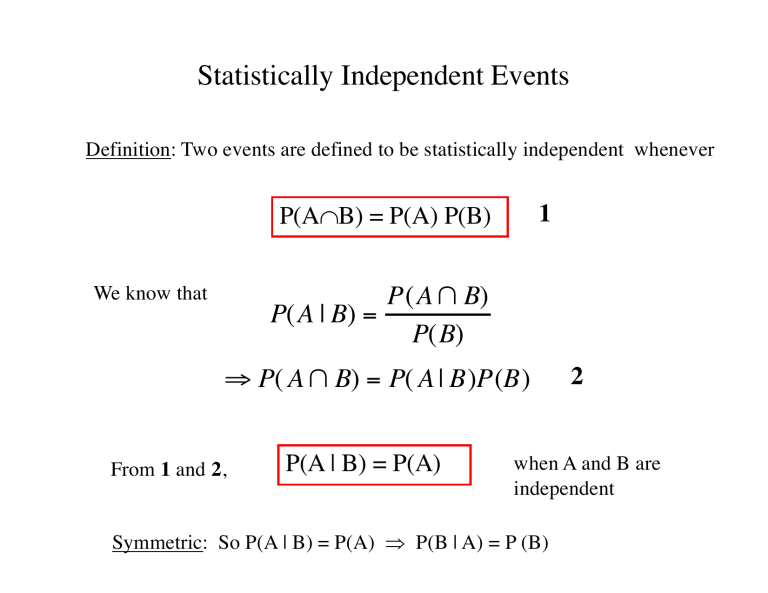
Statistically Independent Events Definition: Two events are defined to be statistically independent whenever 1 P(AÇB) = P(A) P(B) P(A ∩ B) P(A | B) = P(B) We know that ⇒ P( A ∩ B) = P( A | B)P(B) From 1 and 2, P(A | B) = P(A) 2 when A and B are independent Symmetric: So P(A | B) = P(A) Þ P(B | A) = P (B) Statistically Independent Events Definition: A set of events are mutually statistically independent if the probability of the intersection of any subset of these events is equal to the product of the probabilities of each of the events. Example: To check if A, B, and C are independent we need to show 1. P(AÇB) = P(A)P(B) 2. P(AÇC) = P(A)P(C) 3. P(BÇC) = P(B)P(C) 4. P(AÇBÇC) = P(A)P(B)P(C) • For 3 or more events, pairwise independence is not enough to ensure independence of the full set of events i.e., conditions 1-3 alone do NOT imply that A, B, C are mutually independent, also need to check 4 • Requirement for mutual statistical independence is stronger than requirement for pairwise statistical independence Principles of Counting 1. MULTIPLICATION RULE: If there is a sequence of k steps in a procedure and the ith step can be performed in ni ways then the number of ways of performing the procedure = n1´ n2 ´ n3 ´ …… ´ nk Example: How many ways are there of dealing four cards? • number of possibilities for the first card = 52 • number of possibilities for the second card = 51 etc. • Using 1: the number of ways of dealing four cards = 52 ´ 51 ´ 50 ´ 49 2. PERMUTATIONS: • A permutation is an arrangement of a specified number of objects in a definite order • The number of different permutations of n distinct objects = n ´ (n-1) ´ (n-2) ´ ….. ´ 3 ´ 2 ´ 1 written as n! (n factorial) Example: Number of permutations: 4 ´ 3 ´ 2 ´ 1 = 24 • The number of different permutations of r objects selected from n distinct objects = n ´ (n-1) ´ (n-2) ´ ….. ´ (n-r+2) ´ (n-r+1) n! Pr = (n − r )! n 4 ´ 3 = 12 Pr n 3. COMBINATIONS: • A combination is a subset of objects selected from a larger set of objects. • Combinations are not distinguished by the order of the objects they contain. Notation 𝑛 𝑟 or 𝐶!" Read “n choose r” Equation: n! C = r!(n − r)! n r Relationship between Permutations and Combinations: # of ways Permutations of a subset of r objects selected from n distinct objects can be generated in two steps: Pr n n r Step 1. Select a subset of r objects from n distinct objects (without paying attention to the order) C Step 2. Order the subset of r objects in all possible ways r! MULTIPLICATION RULE n r Þ C × r!= Pr n Binomial Probabilities The binomial probability model for a set of subexperiments is defined by 3 fundamental assumptions • Each subexperiment, called a trial has two possible outcomes, called a success and a failure • individual trials are independent • the probability of a success is the same for every trial Probability of k successes in n trials Let the probability of success on a trial \ The probability of failure on a trial =p = 1-p Let the probability of a particular sequence with k successes in n trials be P1 If there a k successes there must be (n-k) failures \ P1 = pk (1-p)n-k Probability of k successes in n trials = number of possible sequences with k successes ´ P1 = n k k C × p (1 − p) n− k
